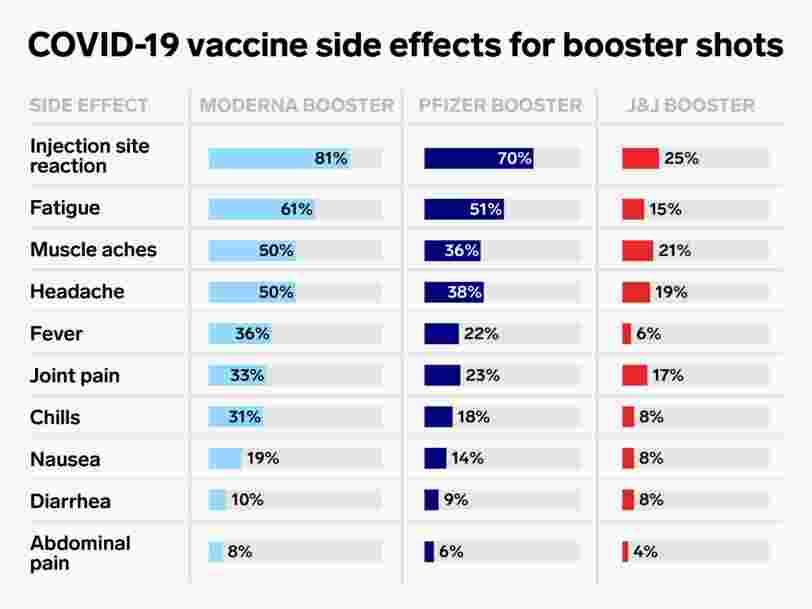One chart shows the most common COVID-19 booster side effects from Pfizer, Moderna, and J&J's vaccines
Aria Bendix,Skye Gould | Publié le | Mis à jour le
- Side effects from COVID-19 booster shots generally resemble those after a second dose.
- Fatigue, headaches, and muscle aches are common after both.
- But two shots of J&J's vaccine yield fewer side effects than three shots of Pfizer or Moderna.
- See more stories on Insider's business page .
Second and third doses of COVID-19 vaccines generally produce similar side effects but there are some slight differences.
In September, the Centers for Disease Control and Prevention (CDC) gave the first comparison between booster shots of all three vaccines available in the US: Pfizer and Moderna (both mRNA shots), and Johnson & Johnson (an adenovirus vaccine).
It's one of the most comprehensive looks at how people are responding to boosters to date.
Broadly, the CDC found that people who'd received three doses of either Pfizer or Moderna saw more local reactions — pain, itchiness, redness, or swelling at the injection site — after dose three compared to dose two. Other side effects such as fatigue, muscle aches, or headaches were less common, affecting 74% after their third dose, compared with 77% after dose two.
A second dose of J&J's vaccine yielded the fewest side effects of all: Only 10% of J&J booster recipients said their side effects prevented them from performing normal daily activities — usually on the day after their booster shot — while the rest said they were able to go about their day as normal.
By comparison, 28% of Pfizer or Moderna booster recipients said the shots hindered their daily routine. However, the study included far more data on mRNA boosters — 12,000 people, compared to 48 who received two J&J doses.
The following table shows how booster shots affected people who got three doses of Moderna, three doses of Pfizer, or two doses of Johnson & Johnson's vaccine, according to CDC data.
Aside from local reactions at the injection site, fatigue was most common among people who received a Pfizer or Moderna booster.
Overall side effects were more prevalent after Moderna's third dose: Half of Moderna booster recipients reported muscle aches and headaches, and around 60% reported fatigue.
Meanwhile, less than 40% of Pfizer booster recipients reported muscle aches and headaches and around 50% reported fatigue.
Just one-quarter of those who received a J&J booster had injection site reactions, compared with 70% who got a Pfizer booster and 80% who got a Moderna booster. And 20% of J&J booster recipients reported muscle aches and headaches.
The CDC recommends boosters for all adults and allows you to mix and match
The CDC now recommends booster shots for all Americans ages 16 and older. People who received two doses of Pfizer's or Moderna's vaccine should get boosted at least six months after their second shot, the CDC advises, whereas J&J recipients can get boosted as early as two months after their first dose.
The CDC has also approved a "mix and match" approach so people can select a booster of a different vaccine type or different manufacturer than their original dose.
An October study funded by the US National Institutes of Health (which has yet to be peer-reviewed) found that mix and match boosters yielded similar side effects to initial vaccine doses. More than half of the study's 458 participants reported malaise, headaches, and muscle aches after their booster while more than 70% experienced mild arm pain.
A UK study similarly identified fatigue, headaches, and pain at the injection site as the most common side effects. The study looked at nearly 2,900 people who had received two doses of Pfizer or AstraZeneca, followed by one of seven different COVID-19 boosters. Overall, side effects from boosters were more common in people ages 30 to 69 than those ages 70 and up, the study found — regardless of which vaccines the participants received.
Fatigue, headaches, and muscles aches were also common after first and second doses
The mRNA vaccines from Pfizer and Moderna instruct the body to produce a harmless viral protein, then develop antibodies against it. The first dose of these vaccines generally produces the mildest side effects , since our bodies are being introduced to the instructions and the resulting protein for the first time.
By the time we receive a second and third dose, our bodies have learned to recognize that protein quickly, so are ready to attack it. That's why side effects are generally more pronounced. (If you've had COVID-19 before, though, your first dose may yield more intense side effects than your second or third, according to one preprint .)
The following chart shows common vaccine side effects based on your age group, vaccine manufacturer, and which dose you received. Data is from each vaccine's clinical trial.
As with a booster shot, fatigue, headaches, and muscles aches were common after doses one and two.
In general, older people experience fewer side effects than younger adults because immune responses gradually weaken with age. That's also the reason why older people are in particular need of boosters: While vaccines still protect against severe disease for now, the Omicron variant seems to increase the risk of reinfection relative to other coronavirus strains.
It's also better than the original virus at evading antibodies from two vaccine doses, early lab studies suggest .
Via PakApNews